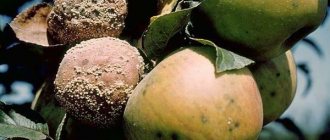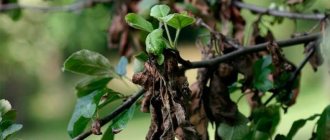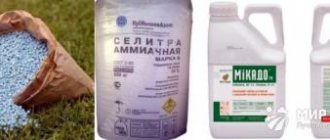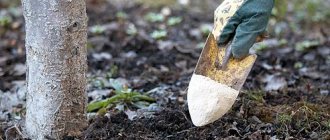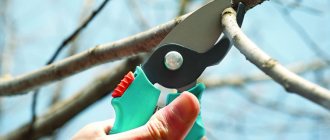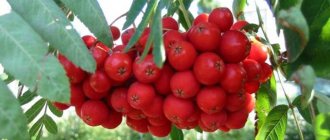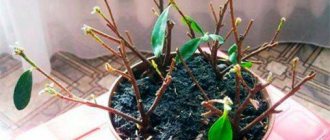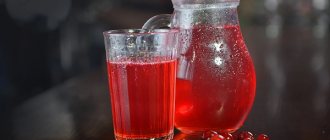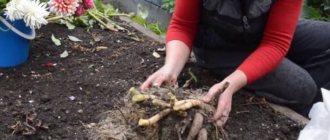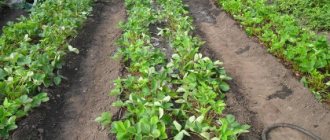Symptoms of the disease
Moniliosis is not as easy to treat as it seems, especially if the disease has progressed. To treat fruit trees you will have to put in a lot of effort and will take a lot of time, and the earlier the disease is noticed, the easier it is to cure the cherry tree.
Photo of cherry disease - Moniliosis
This disease is a real scourge for all stone fruit trees, including peaches, plums, cherry plums, apricots and some others. Gardeners also call this disease gray mold.
The disease spreads most actively in cool climates and increased air and soil humidity.
EXCELLENT VARIETY OF CHERRY!
Bryansk pink cherry
Since this disease is fungal, it spreads through spores. Moreover, the spores may be in another garden, but are carried to other areas by wind or rain. Also, insect pests that move or fly from site to site can be carriers of moniliosis spores.
Overview of the disease - Moniliosis - video
The main symptoms of moniliosis or gray mold:
- the foliage turns yellow and dries, falling off over time;
- the berries stop developing, their growth stops, they darken and shrink;
- rotten fruits do not fall off, gradually mummify and can hang on the shoots for up to several seasons;
- the taste of the pulp of cherries becomes bitter;
- shoots from last season are covered with pads containing spores;
- buds and flowers affected by the fungus also dry out;
- a large number of black thin branches appear on the trees;
- the part of the cherry trunk affected by moniliosis becomes black and shrinks, looking like burnt in appearance;
- Every year, in the spring, damage to healthy parts of the cherries begins, and the shoots and berries affected last season remain the same.
How to recognize a monilial burn, signs of infection
The development of pathology can be suspected by the rapid drying of flowers and young branches. Subsequently, old shoots are also involved in the process. As the disease progresses, the flowers fall off, leaving no ovaries. At the same time, the foliage acquires a brick tint and withers.
When a tree is damaged during the fruiting period, the berries begin to rot and then mummify. They become covered with sandy or gray warts the size of a pinhead.
Important! Moniliosis equally quickly affects stone fruit and pome trees. One infected plant can lead to the death of all crops on the site.
As the disease develops, the berries rot and mummify.
Spread of the disease
Cherry disease moniliosis is widespread in many Russian regions with temperate climates, in particular:
- in the central regions of the European part;
- in most regions of Siberia;
- in the North-West region;
- in the Far East;
- in the foothills of the Caucasus;
- in most regions of the Urals.
Cherries are also affected by moniliosis in Belarus and Ukraine.
Treatment of the disease, what methods can be used at different stages
The appearance of an infectious disease is possible 1-2 weeks after the end of flowering. If measures are not taken immediately, there is a risk of damage to healthy plant fragments and damage to other crops. Combination therapy in the initial stages allows you to avoid dangerous consequences. For this purpose, chemicals and folk recipes are used.
Using chemicals
To treat cherry moniliosis, fungicides are used, which provoke disruption of metabolic processes in fungal cells. At the same time, it is important to avoid irrigating trees in time. Otherwise, the berries will begin to absorb dangerous chemicals. Harvesting is allowed only a month after treatment.
Causes of moniliosis on cherry trees
Typically, this fungal disease is activated when the cherry blossoms. The fruiting body, which contained the spores until this moment, ruptures, and the spores fall out and scatter throughout the area.
The disease is caused by the fungus Monilia, which initially gets into the pistils of flowers, and then spreads throughout the entire above-ground part of this stone fruit tree.
The spread of the disease is facilitated by a drop in air temperature to 15-17 degrees Celsius and air humidity above 95%.
Interesting!
If the spring in the region is prolonged and accompanied by rains, then monilial burn on cherries may appear in those areas where it has not previously appeared.
The transfer of fungal spores is facilitated by strong winds, precipitation and the activity of insect pests.
First, the fungus begins to multiply on the flowers, then it is transferred to the shoots, which become covered with a gray coating and become brittle.
What is cherry moniliosis, causes of infection and methods of spread
The causative agent of moniliosis is a marsupial fungus of the species Monilia cinerea. The distribution area of the disease is the middle zone, Altai, Ural, south and north-west of the Russian Federation.
The fungus is activated in cool and humid weather, with frequent temperature changes. It spreads with the help of wind, insects and rain moisture. Infection is also facilitated by dense crowns or close proximity of trees to each other, and uncollected plant debris. More often, trees affected by scab and pests suffer from this disease. The disease manifests itself in two forms: fruit rot and monilial cherry burn.
How to protect a cherry orchard from moniliosis
The main factor in preventing this fungal disease is the implementation of preventive measures and timely detection of symptoms of the disease. It is important to ensure good care of the cherry orchard, as well as timely preventive spraying of trees against fungal diseases and pests.
You also need to regularly inspect trees for disease damage and, at the first signs of moniliosis, begin to fight it.
Prevention
The key to healthy trees and a high-quality harvest lies in correctly carried out preventive measures.
- Plant cherry trees on plains and hills. The areas should be well lit by the sun.
- Do not choose places with flooding. Make sure that the groundwater level is deeper than 1.5 meters from the ground surface.
- The distance between fruit trees in the garden should be more than 3 meters.
- Old crowns should be regularly rejuvenated.
- Irrigate and fertilize the cherries in a timely manner, which will enable the tree to resist fungal pathogens.
- Whitewash the trunks.
- Loosen row spacing and remove shoots in a timely manner. For the winter, dig around the tree trunks.
- During the growing season, use only safe biological preparations.
- Spray cherry trees with insecticide preparations, destroying harmful insects that carry fungal spores.
Cherry tree pruning diagram.
Frequency of spraying
The fight against moniliosis occurs throughout the entire period, starting in early spring. For preventive purposes, spraying is performed:
- before the opening of flower buds, in the green cone stage;
- in summer, after flowering, when the ovaries are formed;
- repeat spraying after 14 days;
- in the fall, after the leaves have fallen, to minimize the number of overwintering mycelia.
When preparing a solution for spraying trees, you should strictly adhere to the dosage specified in the instructions for the drug. Fungicides are applied a month before harvest.
Traditionally, copper-based preparations are used against monilial burns and other fungal diseases. They suppress the activity of parasites and help plants cope with the disease. This material will tell you about the characteristics and description of the Orange tomato variety.
The crown of large trees is quite difficult to properly treat with a solution. Therefore, you should carefully spray the skeletal branches and trunk, which will increase the stability of the tree.
Trimmings
It is not possible to cure cherries from moniliosis solely by spraying.
Comprehensive measures are required, which also include pruning and destroying diseased parts of the tree. Weak branches damaged by fungus, lichens or insects must be pruned. This is done in late autumn or early spring before the buds open. After flowering ends, the condition of the trees is determined. In diseased areas, it is important to make the cut correctly to prevent the infection from spreading down the healthy shoot. Remove the dry branch in such a way as to capture healthy buds below the drying areas.
Timely formation of the crown is considered a good preventative measure. Cutting out weak shoots reduces the risk of infectious diseases. Read how to treat cherries against worms and other insects here.
Preventive actions
A very important factor in preventing moniliosis is the implementation of preventive measures. First of all, it is necessary to regularly treat all fruit trees against pests. When carrying out various activities to care for cherries, it is necessary to avoid mechanical damage to tree branches and trunks. All wounds should be treated with a disinfectant solution.
Photo of cherry treatment against pests
It is also necessary to carry out spring and autumn formative and sanitary pruning of cherry trees. The main emphasis is on removing damaged and diseased shoots, as well as those branches that thicken the tree crown. If the crown is too thick, then “harmful” bugs may be hiding in the thickets.
After the leaves have completely fallen, the trunks of cherry trees are treated with a special paint. Fallen leaves, as well as plant debris in the tree trunk area, must be collected and burned. They cannot be placed in a compost pit, since the fungus does not die at subzero temperatures, and when it gets into the soil under healthy cherries, it infects them too.
Photo of cherry pruning
When choosing cherry seedlings for planting on your site, you need to choose varieties that are highly resistant to moniliosis.
When planting, you should maintain a certain distance between neighboring cherries - they should be at least 1.5-2 m apart from each other.
INTERESTING!
Preparing currants for winter and caring for berry bushes in the fall
Before the onset of cold weather, cherries should be prepared. Trees must be sanitized. All dry and affected shoots are cut back to living tissue, the cut areas are treated with a weak solution of potassium permanganate and covered with garden varnish. All diseased parts of the tree are collected and burned outside the site.
Moniliosis. Treatment and prevention - video
Treatment of moniliosis of stone and pome crops
Apple (pear) moniliosis
For stone fruit crops, moniliosis is the most harmful disease, since after damage the fruits become unsuitable for food. The tree is infected by conidia of Monilia fructigena. Signs of the disease on apple and pear trees look like this: first, a rounded brown spot forms on the fruit, then it quickly grows and eventually covers the entire fruit or most of it. The fruit becomes brown, and its pulp completely loses its taste.
Moniliosis also manifests itself in the form of a burn, which is caused by conidia of Monilia cinerea. Monilial burn causes flowers, ringlets, twigs and twigs of fruit trees to turn brown and dry. The greatest likelihood of this form of moniliosis occurs in years with very snowy winters, followed by a long, wet and cold spring.
- Late blight: control and treatment, remedies for late blight
To reduce the risk of moniliosis on your apple and pear trees during the growing season, collect and destroy carrion and dried fruits, trim and burn diseased branches and shoots. Do not neglect preventive measures that can prevent mechanical damage to fruits: treat trees against both diseases and pests. Carry out preventive treatments of apple and pear trees with fungicidal solutions throughout the season, using the preparations Horus, Strobi, Abiga-Pik, Gamair, Alirin-B or Planriz. And be responsible for carrying out agrotechnical activities.
Cherry moniliosis
Of the stone fruit crops, moniliosis affects not only cherries and cherries, but also cherry plums, plums, apricots and peaches. The disease is caused by the fungus Monilia cinerea, which overwinters in infected branches and mummified fruits, so in the spring many people mistake the death of branches from monilial burn for winter freezing. In cherry and sweet cherry trees affected by moniliosis, flowers, leaves, and fruit branches wither and dry out, and young, non-lignified shoots look as if they were burned by fire.
Fungal spores land on the pistil and germinate, affecting the blood vessels during flowering. Moniliosis on stone fruit trees, as well as on pome trees, develops in two forms: as monilial burn and as gray rot (fruit rot). First of all, fruits that have mechanical damage become infected with rot: rapidly growing dark spots appear on them, sometimes covering the entire fruit, on which sporulation pads subsequently appear. Gradually, such fruits wrinkle and dry out.
In the photo: Cherry branches affected by moniliosis
The causative agent of moniliosis overwinters in the affected ground organs of the tree, and in the spring it manifests itself as spores spread by wind, rain or insects to neighboring healthy plants. The primary infection passes through the pistils, then the mycelium penetrates the bark and wood through the peduncle and partially destroys it, blocking the flow of moisture, causing the part of the branch above the point of penetration of the fungus to dry out. If dark rings are visible on the cut of the branch, then you are definitely dealing with moniliosis.
All drying branches should be pruned, including 10-15 cm of healthy tissue, the affected fruits should also be removed from the tree, and all these plant remains should be burned, since only fire will certainly destroy the causative agents of moniliosis. Cherries showing signs of the disease, as well as trees adjacent to them, should be treated with Bordeaux mixture or a solution of Abiga-Pika, Horus, Topsin-M, Kuproxat, Fitoflavin or Fitosporin-M. For processing, choose a dry and windless day.
You can avoid problems with moniliosis if you grow cherry varieties in the garden that are resistant to this disease, for example, such as Anadolskaya, Shokoladnitsa, Alexa, Tamaris, Novella, Brunette, Nochka, Shalunya, Bystrinka, Turgenevka, Oktava, Pamyati Vavilov and Shpanka Krasnokutskaya . But felt cherry and the Lyubskaya and Vladimirskaya varieties, on the contrary, are very susceptible to moniliosis.
Moniliosis of plum
Symptoms of moniliosis on a plum tree are not much different from the signs of the disease on other fruit crops: fruits turning brown and covered with sporulation pads, branches, leaves and flowers that are dried out as if burnt. Old branches crack, gum protrudes on them, forming sagging. By the way, with moniliosis (fruit rot), the spore pads are located chaotically on the fruit, while with gray mold infection they form concentric circles.
- Black spotting: treatment and prevention, control measures
How to treat moniliosis on plum? The same as on apple, pear, cherry and cherry trees: carry out timely preventive measures to combat pests (weevils, moths, goose moths and others), try not to damage the organs of the tree, collect and burn diseased fruits and branches. It is very important to carry out preventive treatments of plum trees and the soil under them before flowering with a one percent solution of Nitrofen, copper sulfate or Bordeaux mixture.
The second spraying of plum trees with Bordeaux mixture or a solution of Zineb, Captan, Cuprosan is carried out immediately after flowering. In the summer, you should treat the plums one more time with one of the listed preparations, with the exception of Bordeaux mixture, as it can cause burns to the leaves. In the fall, plums are again treated with Nitrophen or copper sulfate, but even better - with a seven percent urea solution. For the winter, tree trunks and the bases of skeletal branches are covered with lime mortar, to which a fungicide is added.
Moniliosis of apricot (peach)
If in May you saw fallen ovaries and flowers near an apricot or peach, and in June you found dried branches on these trees, and a little later - darkened, withered leaves and browned fruits, then your trees are sick with moniliosis. Upon closer examination, you can find other signs of the disease that we have already described: light gray or cream sporulation pads on the fruits, cracks and gum deposits on the branches.
As a result of the development of moniliosis in apricots and peach, the yield sharply decreases, and only a few fruits remain unaffected by rot, but they also burst over time before they have time to ripen. Apricots and peaches become infected with the disease in the same way and under the same conditions as other fruit trees.
In order to prevent the development of the disease, it is necessary to follow the agricultural practices of the crop, regularly care for the trees, carry out timely pruning and preventive measures to protect them: before flowering, after it, 1-2 times in June and July and 1-2 times after harvesting apricots and peaches must be sprayed with fungicides Horus, Bordeaux mixture, Mikosan-B and other preparations of similar action. Treatment of trees in late autumn is of great importance: if you carry it out, the effectiveness of the first spring spraying will increase many times over.
You should also trim diseased branches in a timely manner, capturing a few centimeters of healthy tissue. In the fall, collect all the affected fruits and burn them along with the pruned branches. And don’t forget to dig up the soil in the tree trunk circles.
Carrying out treatment
However, even if all preventive measures are taken, sometimes cherry trees are still affected by this fungal disease. Therefore, even after preventive spraying, you should regularly inspect fruit trees so that if a disease is detected, you can immediately begin to fight it.
Treatment of moniliosis in cherries is carried out in different ways - it all depends on the stage of the disease. In severely neglected cases, this stone fruit tree cannot be saved - it has to be uprooted and burned outside the site, and the soil must be treated with disinfectant solutions.
Treatment with chemicals
The most effective against this fungal disease are chemicals. Before sap flow begins and at the moment of bud break, cherry trees should be treated with a 2-3% solution of Bordeaux mixture (or copper sulfate). The trunks must be whitened with a lime solution, to which copper sulfate and antifungal drugs have been added.
An effective measure to combat moniliosis is spraying cherry trees before flowering with copper oxychloride (0.3%). You can also treat trees with a 0.4% Zineb solution. But it is not always possible to spray cherries within the specified time frame. In this case, it is necessary to treat the cherry trees during budding with a 1% solution of the drug Topsin-M. If necessary, treatment with this drug is repeated a couple of more times with an interval of 6-8 days.
To treat cherries against moniliosis, the following drugs are used:
- Strobe,
- Topaz,
- Tsineb,
- copper oxychloride,
- Topsin-M,
- inkstone,
- Cuprosan.
Means of struggle
Popular chemical and biological drugs
Depending on the specific conditions, from 3 to 5 fungicide treatments are carried out during the growing season. It is recommended to use different drugs alternately.
Horus
The trees are sprayed the first time before flowering, the second time after flowering. When using a fungicide, take into account the air temperature. It should be no lower than 3–10°C and no higher than 22°C.
To prepare a solution, 1.5 g of fungicide is added to 5 liters of water. One tree requires 2–4 liters of solution.
Topsin M
Systemic fast-acting fungicide. It begins to fight the pathogen within the first day after use. The protective effect lasts up to 3 weeks. The dosage of the drug is 15 g of powder per 10 liters of water.
Topaz
To spray fruit trees, use 3.0 ml of the drug per 10 liters of water. It is recommended to apply the fungicide 2-3 times before and after flowering. It begins to manifest its properties within 3 days.
Hom
Copper oxychloride is one of the effective remedies for moniliosis. Protects for 14 days after treatment. According to the instructions, 40 g of powder is diluted in 10 g of water. Spray plants in calm weather. One tree will require 2–5 liters of solution.
Zircon
Plants are sprayed with a solution of the drug during bud break, during budding before flowering and after harvesting the fruits. The dosage of the drug is 1 ml per 10 liters of water. The trees are sprayed again the following year.
Fitosporin-M
The biofungicide is used during leaf blossoming, at the beginning of flowering and ovary formation. The working solution is prepared at the rate of 20 ml of the drug per 10 liters of water.
Traditional methods
- An iodine solution inhibits the spread of fruit rot (40 drops of iodine are required per 10 liters of water). Trees are processed when the fruits grow to the size of a pea.
- In early spring, tree branches and leaves are sprayed with urea. It not only serves as a top dressing, but also cleanses pathogen spores well - 600 g of urea is added to 10 liters of water.
Cherry varieties resistant to moniliosis
Unfortunately, at present, breeders have not been able to develop cherry varieties that are completely resistant to moniliosis.
However, there are already varieties of cherries that are resistant to moniliosis:
- Turgenevka,
- Tamaris,
- Cossack girl,
- In memory of Vavilov,
- Nefris,
- Memory of Enikeev,
- Novella,
- Minx,
- Alexa,
- Chocolate girl,
- Brunette,
- Shpanka and Shpanka early,
- Novodvorskaya,
- Anadolskaya.
How it appears on felt cherry
The first information about felt cherry appeared at the end of the 19th century. This variety was brought to Russia from China. The fruit tree prefers a humid climate, so it often suffers from moniliosis. Within a few years, the disease can completely weaken the plant. At the end of the flowering period, the branches turn black, the leaves fall off, and the tree begins to dry out at the top. In winter, the affected shoots serve as a haven for fungal infections. And with the arrival of spring, the fungus is carried by the wind, affecting neighboring varieties of cherries.
The fight against monilial burn on felt cherry occurs in several stages.
- Treating the tree with Zircon during the appearance of buds and blossoming of flowers, as well as after flowering. Spraying can be carried out together with the drug "Epin-extra".
- In spring , remove all damaged branches. They are cut down to living tissue, and the areas are treated with garden varnish. Immediately after this, Bordeaux liquid (1%) is used.
- Treat with copper-containing drugs. In this case, the drug “Nitrafen” is suitable, which is diluted in a proportion of 200 grams per 10 liters of water. Spraying is carried out directly in early spring and late autumn.
- The remedy for combating moniliosis "Hom" is used in the summer after sanitation.
As a preventive measure, mineral fertilizers containing copper, boron, manganese, and zinc are applied. All rotten fruits must be burned. This requirement is acceptable not only for felt, but also for other varieties of cherries.
In case of monilial burn, it is recommended to treat felt cherries with antifungal agents.
How does plum blight affect the development and productivity of the tree?
The consequences of moniliosis can be very disastrous for a plum tree. An advanced infection penetrates the wood tissue, causing it to crack and shoots to die. The bark bursts, gum production appears, and the plant weakens greatly.
Causative agents of other diseases and insect pests easily land on a weakened tree. Collectively, they are capable of destroying a plum in 2 seasons, if it does not freeze in the first winter.
Crop losses can reach 100%. Moniliosis greatly reduces the keeping quality of fruits even without visible signs of damage. Within a few days after being stored, they begin to deteriorate and foci of sporulation develop on the skin.
Fruits collected from a tree that has suffered from moniliosis must be carefully sorted and processed
What else can damage cherries?
In addition to fungus, cherries can be damaged by various insects and other diseases.
The most common diseases include:
- clusteropsoriasis, manifested in the form of brown spots and holes on cherry leaves;
- coccomycosis is a disease in which gray spores appear on fruits, resulting in a decrease in frost resistance and yield;
- scab is a disease in which dark spots appear on leaves caused by fungal spores.
In addition to fungal diseases, cherries can be susceptible to attack by various insects, which include:
- cherry sawfly is a pest that destroys the leaf frame;
- cherry weevil - a pest beetle that feeds on young leaves and ovaries of the cherry tree, lays eggs in the berries;
- aphids attack the foliage, suck out the sap, almost completely dehydrating the tree.
In order to avoid problems with cherry diseases and pests, you need to carefully follow preventive measures. When the first signs appear, you must immediately begin treatment and control of pests or fungi. Various pesticides, antifungal agents, trimmings and traditional old-fashioned methods are suitable for this. Such simple measures will not only cure, but also prevent the death of the tree.
Prevention is the best method to combat moniliosis
In order not to treat the tree, you need to periodically carry out preventive treatment:
- Leave enough space between trees. This is necessary so that the roots do not rot and have enough space to develop. It is important to consider that the root system is 2 times the size of the crown.
- Do not damage the tree mechanically.
- Remove weeds and vermin as they can carry this fungus.
Remove weeds and pests
- Perform spring pruning. This will help get rid of dried branches that may become infected after winter.
- Treat cherries in advance against moniliosis in the spring with special antifungal agents.
- Don't water too much. Cherry trees do not like large amounts of moisture, so you need to control watering.
- Various fertilizers can also be used to prevent disease.
Important! The best preventative measure is to plant a cherry variety that is resistant to moniliosis.
Eliminating a fungal scourge always requires time, nerves, money spent on buying drugs and fears that, due to chemicals, ripe cherries cannot be given to children. Therefore, careful garden care is rightly considered the best solution, and priority measures include:
- purchasing seedlings of exclusively zoned varieties from reliable producers;
- professional pruning using garden varnish or kuzbasslak on wounds;
- periodic inspection of trees and sanitary cutting of affected branches;
- cleaning up fallen leaves and branches and always burning them;
- preventive treatment with copper sulfate.
Parasitic fungal diseases are the scourge of gardens in the middle zone with its changeable spring weather, too extreme for delicate stone fruit crops. However, attentiveness, accuracy and regularity will help the gardener get rid of even such an unpleasant disease as moniliosis.
Remember
- Treat mechanical damage. Disinfect damage to the trunk, bark, branches. Any scratches, broken branches and holes in the tree bark made by parasites are a “gateway” for fungal diseases.
- Trim dry branches in a timely manner . They often break off on their own, creating mechanical damage through which infection enters.
- Every autumn, burn fallen leaves and rotten fruits . Spores of moniliosis fungi can overwinter in rotting leaves and spread through rotten fruits.
- Start treatment immediately . As soon as the first signs of the disease are noticed, otherwise it will quickly spread throughout the garden.
In the video, an expert from the Greensad garden center talks about moniliosis
conclusions
- Moniliosis is a fungal disease that affects many varieties of cherries, including Nochka and Shubinka, as well as peaches, plums, cherry plums, and cherries.
- The fight against this disease consists of a set of measures: pruning, spraying, care.
- When cherry berries are ripe, you should not spray them with fungicides. Biological preparations that are more gentle for fruit trees.
- The choice of cherry variety should be based on the climatic zone of planting.
- Timely destruction of affected fruits and shoots will significantly reduce the likelihood of infection spreading.
- Fertilizing with mineral fertilizers and timely watering increases the tree's resistance to fungal diseases.
